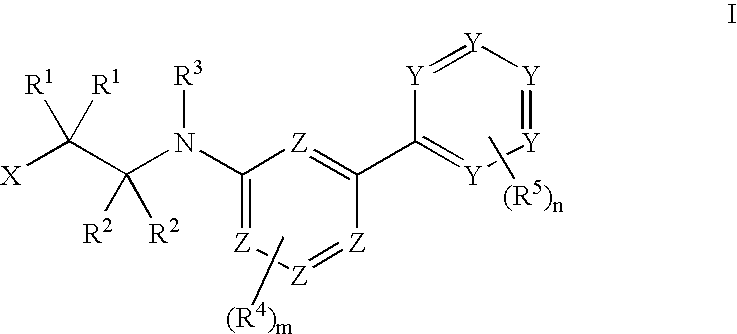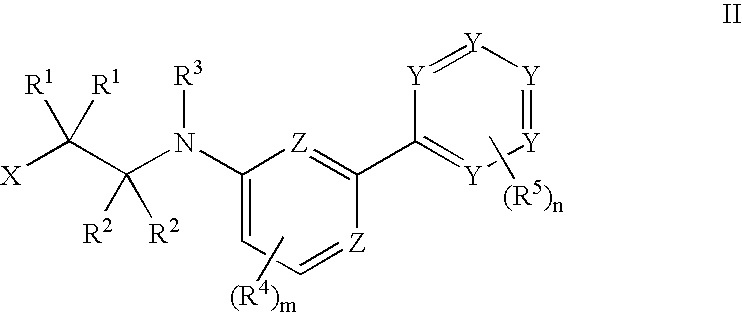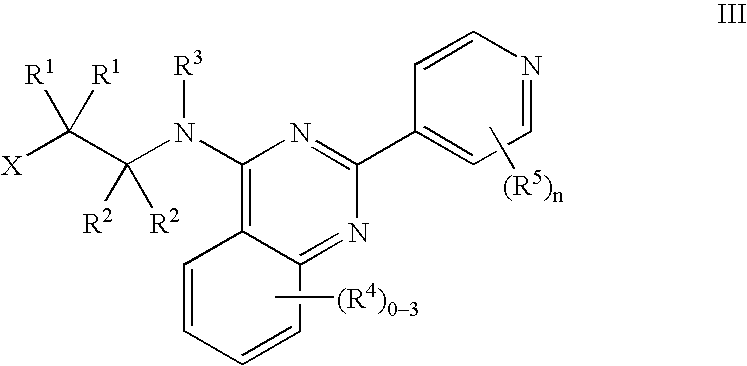Tie-2 modulators and methods of use
- Summary
- Abstract
- Description
- Claims
- Application Information
AI Technical Summary
Benefits of technology
Problems solved by technology
Method used
Image
Examples
example 1
[0186] 2-Pyridin-4-ylquinazolin-4(3H)-one: To a flask of anthranilamide (1 mmol) was added 4-pyridine carboxaldehyde (1 mmol) to form a paste. Followed by the careful addition of 2,3 dichloro-5,6-dicyano-1,4-benzoquinone, (0.5 mmol), the well blended mixture was microwaved in a beaker with silica for 9 min. To the resultant solid was added methanol with subsequent sonication. The collected filtrate was concentrated and dried in vacuo to afford the desired product as a brown solid (85% yield). 1H NMR (400 MHz, d6-DMSO): δ 12.80 (br s, 1H), 8.80 (d, 2H), 8.20 (d, 1H), 8.12 (d, 2H), 7.88 (t, 1H), 7.80 (d, 1H), 7.60 (t, 1H). MS (EI) for C13H9N3O: 224 (MH+).
[0187] 4-Chloro-2-pyridin-4-ylquinazoline: 2-Pyridin-4-ylquinazolin-4(3H)-one (1 mmol) and PCl5 (1.5 mmol) were suspended in POCl3 (12 mmol). The reaction mixture was brought to reflux over 4 h. The solvent was concentrated to dryness and the amorphous residue was partitioned with ethyl acetate and ice water. The aqueous layer was ex...
example 2
[0265] Scheme 9 shows that intermediate (xiv) can be made via thioamide (xviii) as an alternative to using aldehyde intermediate (xiii) as outlined in Scheme 7 above.
[0266] 2-Pyridin-4-yl-7-(trifluoromethyl)quinazolin-4-amine: Isothionicotinamide (1 mmol) and 2-amino-4-trifiuoromethylbenzoic acid (1 mmol) were fused in a pressure tube under nitrogen atmosphere for 15 min. Upon cooling, the material was extracted with methanol and concentrated on a rotary evaporator. The residue was suspended in POCl3 (12 mmol) and PCl5 (1.5 mmol) was added. The reaction mixture was brought to reflux over 4 h. The solvent was concentrated to dryness and the amorphous residue was partitioned with ethyl acetate and ice water. The aqueous layer was extracted with additional ethyl acetate and the combined organic layers were washed with 10% Na2CO3 and brine and dried over magnesium sulfate. The filtrate was concentrated and dried in vacuo to afford the desired product as a brown solid. (60% yield). 1H ...
example 3
[0268] Scheme 10 shows how compounds, (xxiii), of the invention are made via 4-chloropyrimidine, (xxii), analogous to 4-chloroquinazoline intermediate (xv) above. Starting acrylonitrile (xix) is reacted with aryl amidine (xx) to give 4-aminopyrimidine (xxi). Sandmeyer reaction of (xxi) gives 4-chloropyrimidine (xxii), which is then reacted with amine (xvi) to give compounds (xxiii).
[0269] (1S,2R)-1-[(2-Pyridin-4-ylpyrimidin-4-yl)amino]-2,3-dihydro-1H-inden-2-ol: A mixture of 4-pyridinecarboxamidine (1 mmol) and 3-ethoxyacrylonitrile (1 mmol) was heated to 120° C. in the absence of solvent for 3 h. The mixture was cooled to room temperature and extracted with methanol. The methanol was removed on a rotary evaporator and the residue was taken up in ice cold concentrated HCl (10 mL). The solution was cooled to 0° C. and sodium nitrite (2.5 mmol) in water (5 mL) was added dropwise such that the temperature was maintained below 10° C. The reaction was stirred for 30 min, then poured ov...
PUM
| Property | Measurement | Unit |
|---|---|---|
| Composition | aaaaa | aaaaa |
Abstract
Description
Claims
Application Information
 Login to View More
Login to View More - R&D
- Intellectual Property
- Life Sciences
- Materials
- Tech Scout
- Unparalleled Data Quality
- Higher Quality Content
- 60% Fewer Hallucinations
Browse by: Latest US Patents, China's latest patents, Technical Efficacy Thesaurus, Application Domain, Technology Topic, Popular Technical Reports.
© 2025 PatSnap. All rights reserved.Legal|Privacy policy|Modern Slavery Act Transparency Statement|Sitemap|About US| Contact US: help@patsnap.com



